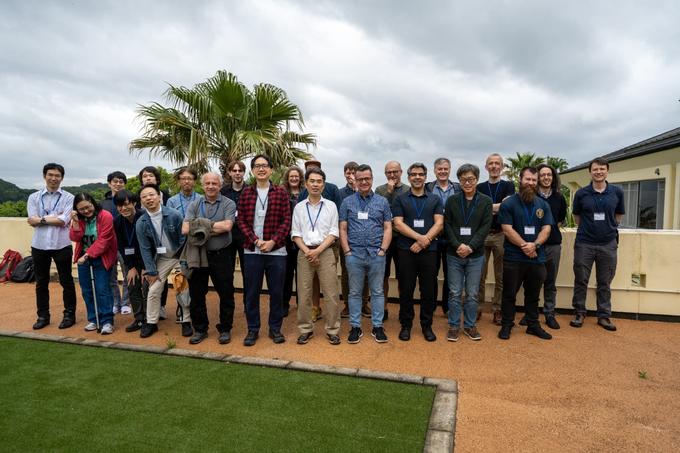Organizers
- Yuta Itoh
- The University of Tokyo, Japan
- Kai Kunze
- Keio University, Japan
- Jason Orlosky
- Augusta University, USA & Osaka University, Japan

Overview
*Important: the venue is changed from Shonan Village Center to Shonan OVA (update on January 30, 2023).
In the past years, there have been two successful Shonan Meetings over Augmented Reality (AR) and Human-Computer Interaction (HCI): the first Shonan Meeting on Perceptual Issues in Augmented Reality (AR) organized by Christian Sandor, Dieter Schmalstieg, and Edward J. Swan II in 2016; and the first Shonan Meeting on AR in HCI organized by Yuta Itoh, Kai Kunze, Alexander Plopski, and Christian Sandor in 2018. Building on the success of the previous meetings held every two years, we propose to organize a Shonan Meeting on Augmented Perception in 2020.
AR technology extends our perceived real world by providing users with additional information and/or interaction schemes. A typical example of such technology is optical see-through near-eye displays (OST-NED) [Sutherland1968] that can overlay a virtual image into the user’s view. As another example, we can use interactive techniques in combination with computer vision algorithms to improve human vision, allowing individuals to see in different spectrums or highlight objects of interest in the world that would otherwise be difficult to notice or invisible. Moreover, vision is not the only sensory functions that AR can enhance. Past AR research works explore AR displays for various sensory modal [Kim2018] including hearing, taste, smell, and touch. In other words, AR technology is by nature a technology that changes or extends our perception. With the rapid development of AR technology, we believe in realizing a future where advanced AR devices virtually enhance our ability in various tasks by assisting our perception. While AR technology has steadily developed to be a commodity tool in our lives [Gartners 2019], not many people have realized its potential in extending human perception and how it could change our future life [Rekimoto1999, Papagiannis2017]. As a natural consequence, we believe that there is an emerging need to explore augmented perception research in more depth.
The concept of augmenting perception [Schmidt2017] is a subtopic of a wider concept of extending human intellect proposed in the 1960s [Engelbart1962]. Assisted by augmented perception devices, the users may be able to process more complex data and/or sense subtle or imperceptible information that our raw sensory system can handle. One example of augmented perception technology is the ChromaGlasses [Langlotz2018] system, which assists color blindness by enhancing colors perceived by the user. The system analyzes the first-person view user and partially modulates the color of the person’s view via see-through image overlay.
The major challenge in augmented perception is that the system of human perception and AR displays can be represented as a loop using various sensory models (Fig. 1). For example, to provide optimized visual stimuli, the development of the ChromaGlasses described above required an understanding of the color perception of a color-blind individual, augmented reality technology, and cognition. Thus, augmented perception technologies must tackle this loop of human perception and the real-world environment for given tasks. To investigate the potential of augmented perception we have included people from various disciplines and backgrounds, ranging from electronics to neuroscience.

Figure 1: A conceptual illustration of the models involved in augmented perception research, which encompass a wide range of disciplines.
This seminar thus aims to rethink how information technology including AR and HCI could modify and extend our perception. The seminar provides a unique opportunity among excellent researchers and students in AR, HCI, Human Augmentation, and cognitive science from all over the world. Not only will participants come from diverse cultural backgrounds, but many participants also have a different and unique research field that will complement the discussions during the meeting.
With this diverse group of participants, we explore how perception augmentation would affect future society. More specifically, our goal is to establish future directions of research and narrow down topics for projects that we can carry out within the next several years. Much like the previous meetings, we expect that participants will build lasting relationships, start new collaborations, and be able to change their way of thinking after listening to the others.
References
- Ivan E. Sutherland. A Head-Mounted Three Dimensional Display. In Proceedings of the Fall Joint Computer Conference, Part I, pages 757–764, New York, USA, December 1968.
- Kim, K., Billinghurst, M., Bruder, G., Duh, H. B. L., & Welch, G. F. (2018). Revisiting trends in augmented reality research: A review of the 2nd decade of ISMAR (2008–2017). IEEE transactions on visualization and computer graphics, 24(11), 2947-2962.
- Schmidt, Albrecht. "Augmenting human intellect and amplifying perception and cognition." IEEE Pervasive Computing 16.1 (2017): 6-10.
- Engelbart, Douglas C. "Augmenting human intellect: A conceptual framework." Menlo Park, CA (1962).
- Rekimoto, Jun, and Katashi Nagao. "The world through the computer: Computer augmented interaction with real world environments." Designing Communication and Collaboration Support Systems (1999).
- Papagiannis, Helen. Augmented human: How technology is shaping the new reality. "O'Reilly Media, Inc.", 2017.
- Langlotz, T., Sutton, J., Zollmann, S., Itoh, Y., & Regenbrecht, H. (2018, April). ChromaGlasses: Computational glasses for compensating colour blindness. In Proceedings of the 2018 CHI Conference on Human Factors in Computing Systems (p. 390). ACM.
